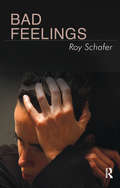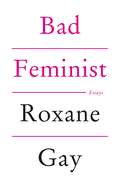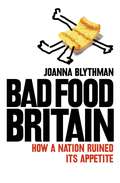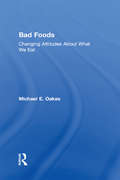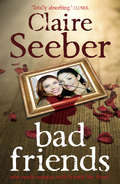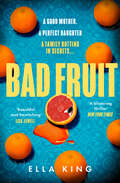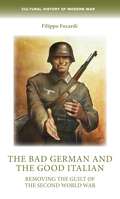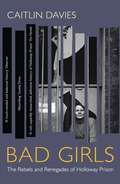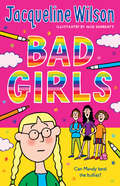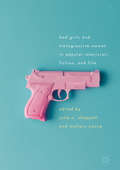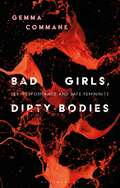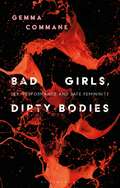- Table View
- List View
Bad Feelings: Selected Psychoanalytic Essays
by Roy SchaferEveryone experiences "bad" feelings - guilt, shame, humiliation, envy and more. Yet despite the fact that such emotions are a common occurrence, these painful feelings are often labelled as wrong, a moralistic determination that can complicate existing problems in the individual's emotional life. Through careful research and assessment of psychoanalytical methods, this book offers a new understanding of how painful emotional states can find relief through the talking cure.
Bad Feelings: Selected Psychoanalytic Essays
by Roy SchaferEveryone experiences "bad" feelings - guilt, shame, humiliation, envy and more. Yet despite the fact that such emotions are a common occurrence, these painful feelings are often labelled as wrong, a moralistic determination that can complicate existing problems in the individual's emotional life. Through careful research and assessment of psychoanalytical methods, this book offers a new understanding of how painful emotional states can find relief through the talking cure.
Bad Feminist: Essays
by Roxane Gay'Pink is my favourite colour. I used to say my favourite colour was black to be cool, but it is pink – all shades of pink. If I have an accessory, it is probably pink. I read Vogue, and I’m not doing it ironically, though it might seem that way. I once live-tweeted the September issue.'In these funny and insightful essays, Roxane Gay takes us through the journey of her evolution as a woman (Sweet Valley High) of colour (The Help) while also taking readers on a ride through culture of the last few years (Girls, Django in Chains) and commenting on the state of feminism today (abortion, Chris Brown). The portrait that emerges is not only one of an incredibly insightful woman continually growing to understand herself and our society, but also one of our culture.Bad Feminist is a sharp, funny and sincere look at the ways in which the culture we consume becomes who we are, and an inspiring call-to-arms of all the ways we still need to do better.
The Bad Fire: A shocking murder case brings danger too close to home for ex-cop Bob Skinner in this gripping Scottish crime thriller (Bob Skinner)
by Quintin JardineThe gritty new mystery in Quintin Jardine's bestselling Bob Skinner series, set in Edinburgh and the Scottish countryside; not to be missed by readers of Ian Rankin and Peter May. Nine years ago, divorcee Marcia Brown took her own life. A pillar of the community, she had been accused of theft, and it's assumed that she was unable to live with the shame. Now her former husband wants the case reopened. Marcia was framed, he says, to prevent her exposing a scandal. He wants justice for Marcia. And Alex Skinner, Solicitor Advocate, and daughter of retired Chief Constable Sir Robert Skinner, has taken on the brief, aided by her investigator Carrie McDaniels. When tragedy strikes and his daughter comes under threat, Skinner steps in. His quarry is about to discover that the road to hell is marked by bad intentions . . .What readers are saying about Quintin Jardine's gripping mysteries: 'I would recommend anyone new to the series to give yourself a treat and read them all!!''I have given this book five stars because of the ingenious plot, the excellence of the narrative and, after quite a number of years, Quintin Jardine is still producing superb crime fiction''A fantastic gripping read and I didn't want to put it down''As always Mr Jardine had me hooked from the first chapter to the very end'
Bad Food Britain: How A Nation Ruined Its Appetite
by Joanna BlythmanAward-winning investigative food journalist, Joanne Blythman turns her attention to the current hot topic – the state of British food.
Bad Foods: Changing Attitudes About What We Eat
by Michael E OakesBad Foods demonstrates how a variety of historical or political events and personalities have shaped our current views of good nutrition. On several occasions in American history concerns have arisen over the safety of our food supply (e.g., harmful ingredients in processed foods) and the potential that processing might deplete foods of their nutrients. These concerns help explain how food characteristics such as freshness, natural, organic, and unprocessed have become important to Americans.Bad Foods traces how the food nutrients fat, salt, and sugar have acquired negative reputations for health as well as any controversies and outright misconceptions of the dangers of these nutrients. Bad Foods also explores confusion that can in part be attributed to biased media coverage about foods. Modern Americans are routinely bombarded with information about the health value of certain foods and the dangers of others. Frequently, health information about certain nutrients receives exaggerated coverage (e.g., dietary fat) while the importance of other nutrients gets ignored (e.g., vitamins and minerals). Moreover, health information about foods is often perceived as contradictory.While some readers may be startled by what they perceive to be a challenge to sacred beliefs about foods, others will see the honesty in both the research and the writing and recognize the social benefits of examining our beliefs about foods. Bad Foods will be of interest to sociologists, food science specialists, and social historians.
Bad Foods: Changing Attitudes About What We Eat
by Michael E OakesBad Foods demonstrates how a variety of historical or political events and personalities have shaped our current views of good nutrition. On several occasions in American history concerns have arisen over the safety of our food supply (e.g., harmful ingredients in processed foods) and the potential that processing might deplete foods of their nutrients. These concerns help explain how food characteristics such as freshness, natural, organic, and unprocessed have become important to Americans.Bad Foods traces how the food nutrients fat, salt, and sugar have acquired negative reputations for health as well as any controversies and outright misconceptions of the dangers of these nutrients. Bad Foods also explores confusion that can in part be attributed to biased media coverage about foods. Modern Americans are routinely bombarded with information about the health value of certain foods and the dangers of others. Frequently, health information about certain nutrients receives exaggerated coverage (e.g., dietary fat) while the importance of other nutrients gets ignored (e.g., vitamins and minerals). Moreover, health information about foods is often perceived as contradictory.While some readers may be startled by what they perceive to be a challenge to sacred beliefs about foods, others will see the honesty in both the research and the writing and recognize the social benefits of examining our beliefs about foods. Bad Foods will be of interest to sociologists, food science specialists, and social historians.
Bad for Good: The must-read crime debut of 2022 (Jo Howe #1)
by Graham Bartlett'Gripping' PETER JAMES'Thoroughly absorbing' ELLY GRIFFITHS'Cracking' MARK BILLINGHAM'Engaging' M.W.CRAVEN---How far would you go?The murder of a promising footballer, son of Brighton's highest-ranking police officer, means Detective Superintendent Jo Howe has a complicated and sensitive case on her hands. The situation becomes yet more desperate following devastating blackmail threats.Howe can trust no one as she tracks the brutal killer in a city balanced on a knife edge of vigilante action and a police force riven with corruption.
Bad for You (Dirty Deeds #3)
by J. DanielsHe didn't want to be bad. He just didn't have a choice...Shayla Perkins isn't the kind of girl who makes the same mistake twice, especially when it comes to Sean "Stitch" Molina. So when he gives her the world's biggest rejection, that's it--she's done. Until the sexy, silent, unavailable Sean makes Shay a very personal offer. Of course, it still doesn't mean he's interested in her. Or does it?Sean has done things in life. Bad things. And he's paid the price. All he wants now is to make up for his past by doing good in the present. And no one deserves more good than Shay. Beautiful on the inside and out, Shay is the kind of woman who should be cared for and protected--especially from a man like Sean. He's tried to keep his feelings for her in check, but a single, reckless impulse pulls them closer than ever before.Soon the two are sharing their biggest dreams and satisfying their deepest desires. But what will happen if the only way to truly give each other what they want most...is to let each other go?Praise for Four Letter Word:'Unique, emotional and addictive' Katy Evans, New York Times bestselling author'Love! That's the four letter word to describe how I felt about this unique, sexy story. J. Daniels' hottest book to date' Penelope Ward, New York Times bestselling author'The perfect mix of funny, hot and heartwarming. I enjoyed it immensely!' Mia Sheridan, New York Times bestselling author
Bad Form: Social Mistakes and the Nineteenth-Century Novel
by Kent PuckettWhat--other than embarrassment--could one hope to gain from prolonged exposure to the social mistake? Why think much about what many would like simply to forget? In Bad Form: Social Mistakes and the Nineteenth-Century Novel, Kent Puckett argues that whatever its awkwardness, the social mistake-the blunder, the gaffe, the faux pas-is a figure of critical importance to the nineteenth-century novel. While offering significant new readings of Thackeray, Flaubert, Eliot, James, and others, Puckett shows how the classic realist novel achieves its coherence thanks to minor mistakes that novels both represent and make. While uncovering the nineteenth-century novel's persistent social and structural reliance on the non-catastrophic mistake-eating peas with your knife, saying the wrong thing, overdressing-Bad Form argues that the novel's once considerable cultural authority depends on what we might otherwise think of as that authority's opposite: a jittery, anxious, obsessive attention to the mistakes of others that is its own kind of bad form. Drawing on sociology, psychoanalysis, narrative theory, and the period's large literature on etiquette, Puckett demonstrates that the nineteenth-century novel relies for its form on the paradoxical force of the social mistake.
Bad Form: Social Mistakes and the Nineteenth-Century Novel
by Kent PuckettWhat--other than embarrassment--could one hope to gain from prolonged exposure to the social mistake? Why think much about what many would like simply to forget? In Bad Form: Social Mistakes and the Nineteenth-Century Novel, Kent Puckett argues that whatever its awkwardness, the social mistake-the blunder, the gaffe, the faux pas-is a figure of critical importance to the nineteenth-century novel. While offering significant new readings of Thackeray, Flaubert, Eliot, James, and others, Puckett shows how the classic realist novel achieves its coherence thanks to minor mistakes that novels both represent and make. While uncovering the nineteenth-century novel's persistent social and structural reliance on the non-catastrophic mistake-eating peas with your knife, saying the wrong thing, overdressing-Bad Form argues that the novel's once considerable cultural authority depends on what we might otherwise think of as that authority's opposite: a jittery, anxious, obsessive attention to the mistakes of others that is its own kind of bad form. Drawing on sociology, psychoanalysis, narrative theory, and the period's large literature on etiquette, Puckett demonstrates that the nineteenth-century novel relies for its form on the paradoxical force of the social mistake.
A Bad Fox (Read Write Inc. Phonics, Set 2, Purple) (PDF)
by Ruth Miskin Tim Archbold Gill MuntonThe Read Write Inc. Phonics storybooks provide structured practice in decoding words and reading through phonics. Each set of books is carefully graded so that children can read them with confidence, as soon as they have learned the sounds linked to the set. There are seven sets of books ,with 10-13 books in each set.
Bad Friends
by Claire SeeberA terrible accident. A secret discovered. An inescapable nightmare. Who needs enemies with friends like these? The unnerving new novel from the acclaimed author of LULLABY
Bad Fruit
by Ella KingEVERY FAMILY HAS ITS SECRETS . . .‘Unforgettable’ RED – ‘Memorable’ OBSERVER – ‘A family overflowing with secrets’ LOUISE HARE – ‘Impossible to put down’ CHRIS WHITAKER – ‘Searing’ ELLE – ‘A chilling literary thriller’ GRAZIA
The bad German and the good Italian: Removing the guilt of the Second World War (Cultural History of Modern War)
by Filippo FocardiIn the Axis War on the side of Germany, Mussolini's Italy was responsible for serious war crimes, especially in Yugoslavia and Greece. This 'dark side' of the fascist war, however, is not present in the national memory built after 1945. To distinguish Italy from the former German ally and avoid a punitive peace, the monarchist and anti-fascist ruling classes elaborated a master narrative that highlighted the opposition of the Italian people to Mussolini's war and the humanitarian behavior of Italian soldiers, depicted as saviors of Jews. All responsibility for the crimes committed in the Axis war was placed on the shoulders of the Germans, who thus became a convenient alibi for the national conscience.
The bad German and the good Italian: Removing the guilt of the Second World War (Cultural History of Modern War)
by Filippo FocardiIn the Axis War on the side of Germany, Mussolini's Italy was responsible for serious war crimes, especially in Yugoslavia and Greece. This 'dark side' of the fascist war, however, is not present in the national memory built after 1945. To distinguish Italy from the former German ally and avoid a punitive peace, the monarchist and anti-fascist ruling classes elaborated a master narrative that highlighted the opposition of the Italian people to Mussolini's war and the humanitarian behavior of Italian soldiers, depicted as saviors of Jews. All responsibility for the crimes committed in the Axis war was placed on the shoulders of the Germans, who thus became a convenient alibi for the national conscience.
Bad Girl
by Roberta KrayThe Quinns are one of the most feared criminal gangs in London's East End.So the reaction of Joe Quinn to the news that his daughter Lynsey is involved with a policeman is predictable and swift, and a pregnant Lynsey finds herself out on the street, bruised and alone.At the age of eleven, Lynsey's daughter Helen is returned to the clan. Hated by her grandfather, loved only by her uncle, she struggles to fit into a world she doesn't understand. As warring factions battle for control of the East End, tragedy is about to strike again.How can Helen survive? And who can she trust when the Quinn family's criminal past comes back to haunt her?
The Bad Girl: A Novel
by Mario Vargas LlosaRicardo Somocurcio is in love with a bad girl. He loves her as a teenager known as 'Lily' in Lima in 1950, where she claims to be from Chile but vanishes the moment her claim is exposed as fiction. He loves her next in Paris as 'Comrade Arlette', an activist en route to Cuba, an icy, remote lover who denies knowing anything about the Lily of years gone by. Whoever the bad girl turns up as and however poorly she treats him, Ricardo is doomed to worship her. Gifted liar and irresistible, maddening muse - does Ricardo ever know who she really is?
Bad Girl Reputation: an addictive second chance romance from the TikTok sensation
by Elle KennedyReturn to Avalon Bay in this sexy second chance story about two exes who can't stay away from each other . . . When former bad girl Genevieve West returns home for her mother's funeral, she's prepared to keep her distance from her ex-boyfriend, Evan Hartley. Their history is rife with turbulence. And passion. A heck of a lot of passion . . . which she's trying desperately to forget.But it's impossible not to run into Evan in the small coastal town where they once ran wild. And the moment she sees her gorgeous ex again, it's clear to Gen that Evan is still as unruly, sexy and irresistible as ever. This time around, however, she's resolved to walk a new path. No more partying. No more foolish mistakes. Her plan is to temporarily remain in town to help her father run his business, but the second he finds somebody else, she's out of there.Evan has other ideas. He knows they can be good together, but he just has to convince Genevieve of that, even if it means turning over a new leaf himself. But can a bad reputation ever truly be shed? Do second chances really work? Genevieve and Evan are about to find out.Why readers love Avalon Bay:'Delicious, complicated and drama-filled. . . I read it in one sitting, and you will, too' L. J. Shen, USA Today bestselling author'A deliciously sexy story with a wallop of emotions that sneaks up on you' Vi Keeland, No.1 New York Times bestselling author'Elle Kennedy delivers another sexy and addictive read, and my latest personal favourite from her!' Tijan, New York Times bestselling author'With plenty of steam alongside the youthful romance, this winsome story about following one's heart will especially appeal to hopeless romantics' Publishers Weekly
Bad Girls: A History of Rebels and Renegades
by Caitlin DaviesLONGLISTED FOR THE 2019 ORWELL PRIZE FOR POLITICAL WRITING'Davies's absorbing study serves up just enough sensationalism - and eccentricity - along with its serious inquiry' SUNDAY TIMES'[A] revealing account of the jail's 164-year history' DAILY TELEGRAPH, 5* review'Insightful and thought-provoking and makes for a ripping good read' JEREMY CORBYN'A much-needed and balanced history' OBSERVER'Davies explores how society has dealt with disobedient women - from suffragettes to refugees to women seeking abortions - for decades, and how they've failed to silence those who won't go down without a fight' STYLISTSociety has never known what to do with its rebellious women. Those who defied expectations about feminine behaviour have long been considered dangerous and unnatural, and ever since the Victorian era they have been removed from public view, locked up and often forgotten about. Many of these women ended up at HM Prison Holloway, the self-proclaimed 'terror to evil-doers' which, until its closure in 2016, was western Europe's largest women's prison. First built in 1852 as a House of Correction, Holloway's women have come from all corners of the UK - whether a patriot from Scotland, a suffragette from Huddersfield, or a spy from the Isle of Wight - and from all walks of life - socialites and prostitutes, sporting stars and nightclub queens, refugees and freedom fighters. They were imprisoned for treason and murder, for begging, performing abortions and stealing clothing coupons, for masquerading as men, running brothels and attempting suicide. In Bad Girls, Caitlin Davies tells their stories and shows how women have been treated in our justice system over more than a century, what crimes - real or imagined - they committed, who found them guilty and why. It is a story of victimization and resistance; of oppression and bravery. From the women who escaped the hangman's noose - and those who didn't - to those who escaped Holloway altogether, Bad Girls is a fascinating look at how disobedient and defiant women changed not only the prison service, but the course of history.
Bad Girls ((adaptation) Ser.)
by Jacqueline Wilson Nick SharrattShy, mild Mandy has been bullied at school for as long as she can remember. That's why she is delighted when cheeky, daring, full-of-fun Tanya picks her as a friend. Mum isn't happy - she thinks Tanya's a BAD GIRL and a bad influence on her daughter. But Mandy loves spending time with her brilliant new friend, and is sure Tanya can only get her out of trouble, not into it . . . or could she?
Bad Girls and Transgressive Women in Popular Television, Fiction, and Film
by Julie A. Chappell Mallory YoungThis collection of essays focuses on the representations of a variety of “bad girls”—women who challenge, refuse, or transgress the patriarchal limits intended to circumscribe them—in television, popular fiction, and mainstream film from the mid-twentieth century to the present. Perhaps not surprisingly, the initial introduction of women into Western cultural narrative coincides with the introduction of transgressive women. From the beginning, for good or ill, women have been depicted as insubordinate. Today’s popular manifestations include such widely known figures as Lisbeth Salander (the “girl with the dragon tattoo”), The Walking Dead’s Michonne, and the queen bees of teen television series. While the existence and prominence of transgressive women has continued uninterrupted, however, attitudes towards them have varied considerably. It is those attitudes that are explored in this collection. At the same time, these essays place feminist/postfeminist analysis in a larger context, entering into ongoing debates about power, equality, sexuality, and gender.
Bad Girls and Transgressive Women in Popular Television, Fiction, and Film
by Julie A. Chappell Mallory YoungThis collection of essays focuses on the representations of a variety of “bad girls”—women who challenge, refuse, or transgress the patriarchal limits intended to circumscribe them—in television, popular fiction, and mainstream film from the mid-twentieth century to the present. Perhaps not surprisingly, the initial introduction of women into Western cultural narrative coincides with the introduction of transgressive women. From the beginning, for good or ill, women have been depicted as insubordinate. Today’s popular manifestations include such widely known figures as Lisbeth Salander (the “girl with the dragon tattoo”), The Walking Dead’s Michonne, and the queen bees of teen television series. While the existence and prominence of transgressive women has continued uninterrupted, however, attitudes towards them have varied considerably. It is those attitudes that are explored in this collection. At the same time, these essays place feminist/postfeminist analysis in a larger context, entering into ongoing debates about power, equality, sexuality, and gender.
Bad Girls, Dirty Bodies: Sex, Performance and Safe Femininity (Library of Gender and Popular Culture)
by Gemma CommaneWhat makes a woman 'bad' is commonly linked to certain 'qualities' or behaviours seen as morally or socially corrosive, dirty and disgusting. In Bad Girls, Dirty Bodies, Gemma Commane critically explores the social, sexual and political significance of women who are labelled 'bad', sluts or dirty. Through a variety of case studies drawn from qualitative and original ethnographic research, she argues that 'Bad Girls' disrupt heterosexual normativity and contribute new embodied knowledge.From neo-burlesque, sex-positive and queer performance art, to explicit entertainment and areas of popular culture; Commane situates 'bad' women as sites of power, possibility and success. Through the combination of case studies (Ms T, Empress Stah and RubberDoll, Mouse and Doris La Trine), Gemma Commane offers a challenge to those who think that sexual, slutty, bad, and dirty women are not worth listening to. Significantly, she unpicks the issues generated by women who are complicit in the subjugation, policing and marginalization of 'other' women, both in popular culture and in sites of subcultural resistance.
Bad Girls, Dirty Bodies: Sex, Performance and Safe Femininity (Library of Gender and Popular Culture)
by Gemma CommaneWhat makes a woman 'bad' is commonly linked to certain 'qualities' or behaviours seen as morally or socially corrosive, dirty and disgusting. In Bad Girls, Dirty Bodies, Gemma Commane critically explores the social, sexual and political significance of women who are labelled 'bad', sluts or dirty. Through a variety of case studies drawn from qualitative and original ethnographic research, she argues that 'Bad Girls' disrupt heterosexual normativity and contribute new embodied knowledge.From neo-burlesque, sex-positive and queer performance art, to explicit entertainment and areas of popular culture; Commane situates 'bad' women as sites of power, possibility and success. Through the combination of case studies (Ms T, Empress Stah and RubberDoll, Mouse and Doris La Trine), Gemma Commane offers a challenge to those who think that sexual, slutty, bad, and dirty women are not worth listening to. Significantly, she unpicks the issues generated by women who are complicit in the subjugation, policing and marginalization of 'other' women, both in popular culture and in sites of subcultural resistance.
